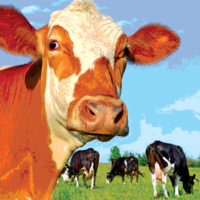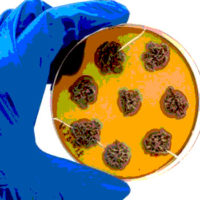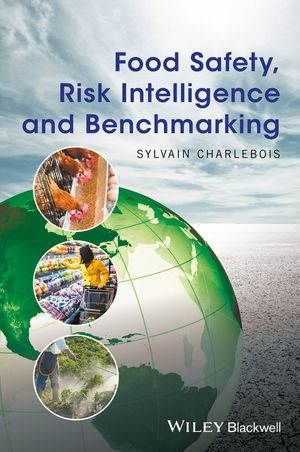Public Health Risk of Antibiotic Use in Food Animals

Many people are concerned about increasing levels of antimicrobial resistance in human pathogens. Infection with a resistant pathogen may result in more prolonged or severe illness. The basic science of bacteria tells us that use of antibiotics will generally increase the proportion of resistant bacteria occurring in those bacterial populations or ecosystems. As resistance increases, the risk of adverse treatment outcomes may also increase. Therefore, all antibiotic use needs to be evaluated and carefully controlled to preserve antibiotics as a healthcare tool in people and animals.
 To mitigate the risk, antibiotic use in humans and livestock is being scrutinized by physicians, veterinarians, consumer groups, Congress and government agencies. Regarding the risk of food animal antibiotics, there has been much alarm about the proportion (60–80 percent) of the total antibiotics produced that is sold for use in food animals in the U.S. Based on these numbers, many suggest that animal use is a major contributor to the resistance problem. Many also suggest we should raise livestock “antibiotic-free.” Recently, I heard a commercial reporting its brand of poultry tasted better as it was antibiotic-free. However, neither the quantity used nor the route by which it is given to animals (e.g., in feed) nor the perceived taste is an accurate measure of contribution to the overall risk. Many more questions along the causal pathway from farm to human health harm must be answered to understand the contribution that food animal use makes to the overall problem (Figure 1).
To mitigate the risk, antibiotic use in humans and livestock is being scrutinized by physicians, veterinarians, consumer groups, Congress and government agencies. Regarding the risk of food animal antibiotics, there has been much alarm about the proportion (60–80 percent) of the total antibiotics produced that is sold for use in food animals in the U.S. Based on these numbers, many suggest that animal use is a major contributor to the resistance problem. Many also suggest we should raise livestock “antibiotic-free.” Recently, I heard a commercial reporting its brand of poultry tasted better as it was antibiotic-free. However, neither the quantity used nor the route by which it is given to animals (e.g., in feed) nor the perceived taste is an accurate measure of contribution to the overall risk. Many more questions along the causal pathway from farm to human health harm must be answered to understand the contribution that food animal use makes to the overall problem (Figure 1).
To clarify, when we talk about resistance, we are talking about the bacterium’s ability to grow in media in the laboratory in the presence of selected antimicrobials. These are not the same as residues that are leftover molecules in the meat and are not allowed by the U.S. Department of Agriculture (USDA). Additionally, it is important to understand that all bacteria may have some natural ability to grow in the presence of some antimicrobials, and just because a bacterium is resistant to a certain antibiotic does not mean that antibiotic treatment in the patient will fail. Resistance sounds like an evil word, but resistance is actually a normal characteristic of most bacteria. Antibiotic resistance has been documented to have existed for millions of years. Most scientists think resistance is a bacterial survival mechanism for competition. Antimicrobial resistance has been found in many places where antibiotics have never been used, including arctic seals, deep ocean trenches and caves untouched by mammals for over 4 million years. So, clearly, resistance has not developed just due to human use.
Given this general understanding of bacteria and resistance development, many people get the impression that antibiotic use is “bad” and the best solution is to severely restrict its use, especially in food animals. However, antibiotics are needed for animal health, which affects food safety, and suggestions to go antibiotic-free may have significant negative consequences.
Many policy questions arise from these issues. How do we preserve this important human and animal healthcare tool? How much of the risk is due to animal antibiotic use? Which antibiotic uses need to be restricted? What ethical and public health benefits, deriving from healthy food animals, need to be considered? Because bacteria are different, just as species of animals are different, and they interact with specific antibiotics differently, these questions must be addressed on a case-by-case (“bug-drug-use”) basis. This approach is outlined in the U.S. Food and Drug Administration (FDA) guidance 152 on risk assessment methods.[1]
This article will briefly mention three important facts that must be entered into this complex policy debate, as follows:
1. The risk to human health that is contributed by most on-farm antibiotic use appears negligible.
2. Failure to prevent or treat illness causes unnecessary animal suffering and death.
3. Animals with residual effects of illness are more likely to cause human foodborne disease.
Risks to Human Health by Most On-Farm Antibiotic Use Appears Negligible
The risk is negligible because it is a long way from farm to harm. There are many barriers and filters in effect along the farm-to-fork chain to prevent and reduce bacterial transmission. These barriers include in-plant Hazard Analysis and Critical Control Points, proper food preparation and cooking and adequate human immunity and wellness. For harm to happen, many events must occur consecutively.
It is important to highlight the difference between concern, hazard and risk. Concern does not equal risk. Concern suggests a need for further investigation and monitoring of an evolving situation. Risk requires a causal chain of events and depends on both hazard and dose (or exposure). Water is a hazard, especially if you are golfing or surfing. The risk depends on a variety of circumstances and skill, all of which affect your exposure or dose.
Many hazardous chemicals are used in food processing. Controlling exposure to those hazards minimizes risk. Antimicrobial-resistant bacteria are a hazard. With sufficient dose or exposure, a hazard can create a risk. So if a hazard is not a risk and antimicrobial-resistant bacteria are a hazard, is there a risk?
To answer this question, we may need to do a risk assessment. We cannot make major policy or regulatory changes based solely on concern. Risk assessment, a specialized form of decision analysis, is a useful method for sorting out such a complex, multifactorial policy decision. This is the approach FDA has been using to evaluate any new animal antibiotic before it is approved for use.[1] Note, this analysis is conducted for a specific antibiotic, for a specific animal use, for specific dose, in selected bacteria.
To generate risk from a hazard requires a causal pathway as shown in Figure 1. In this complex system of antimicrobial resistance, there is a chain of causality, as there is in every risk assessment. This chain is as follows: Antibiotics are used in livestock, antibiotic resistance develops on farm, these resistant bacteria are present on meat, meat is not cooked or handled properly, these resistant bacteria present on food cause human illness, the human receives antibiotic treatment, treatment is ineffective and there are additional illness days in the human due to resistance. FDA has suggested the foodborne route as the most likely to produce risk and is the only route required for regulatory approval of animal antibiotics. Each of these steps must happen and proceed to the next step; if one step (domino) is removed or severely restricted, the entire causal chain is stopped or restricted.
Many quantitative risk assessments have examined the risk of antimicrobial-resistant bacteria causing foodborne illness. To date, none of the peer-reviewed scientific quantitative risk assessments published have demonstrated any significant risk of treatment failure in humans caused by current on-farm antibiotic uses in animals. So while the critics of on-farm antibiotic use may have valid concerns, the science suggests, except for a few specific cases, the actual risk does not justify broadly restrictive antibiotic-use policies.
A very simplistic form of risk assessment is provided by the Infectious Diseases Society of America and the U.S. Centers for Disease Control and Prevention. They provided a list of bacteria of concern for human infectious diseases and resistance.[2] Most of the bacteria listed are unrelated to farms and livestock. These bacteria are either not transmitted through eating meat or are treated by antimicrobials that are not used in food animals (thus the resistance cannot come from on-farm use), are strictly human pathogens or have no otherwise known connection between people and food-producing animals.
Failure to Prevent or Treat Illness Causes Unnecessary Animal Suffering and Death
Every farm with animals is both a maternity hospital and/or a day care facility. Animals need medicine, just like kids do. Infection can move quickly through a house or barn, just like a day care facility. This becomes a moral and ethical issue. At what point will we deny treatment? It’s not right to withhold veterinary care from animals just for economic gain.
Organic or antibiotic-free farms face an ongoing challenge: How long does the farmer wait before treating? Most marketing programs for antibiotic-free require that an animal treated with an antibiotic cannot be sold as antibiotic-free or organic. Treatment of an animal results in a significant financial loss for the producer. So if a farmer is faced with a barnful of coughing and dying pigs, for example, the best treatment is water medication of the entire barn, which would stop the rapid spread of infection. However, antibiotic treatment would cause the entire barn to be a “loss.” All those treated pigs would be sold at a discount.
Animals with Residual Illness Are More Likely to Cause Human Foodborne Disease
I am not saying there is zero risk from on-farm antibiotic use. Therefore, if we as a society are to accept that risk, there should be some benefit. Let’s compare this with something we all know well: chlorinated water. The U.S. Environmental Protection Agency originally did not want to approve chlorination, because chlorinated water can increase the risk of cancer. Finally, the agency did approve it because of the benefit derived from avoiding an alternative and greater risk: bacteria, viruses and other pathogens routinely found in water. So we need to evaluate the alternative public health risk for withholding antibiotic use in food animal production.
People want to consume meat only from healthy animals. This tenet was established in the 1906 Meat Inspection Act.[3] Only healthy animals should enter the food chain. However, it is not just the obviously sick animals that create public health problems. Additionally, animals with subclinical (not visible while alive) residual effects of illness are more likely to cause human foodborne illness. As we harvest animals with some residual or leftover illness effects, we will increase the public health risk from susceptible (nonresistant) bacteria. This connection between subclinical animal health and carcass contamination with foodborne pathogens has been demonstrated in a few studies.
Research has shown that chicken flocks arriving at harvest with airsacculitis lesions (similar to pneumonia) had lower average bird weights, higher levels of fecal contamination on the carcass and increased Campylobacter loads than flocks without airsacculitis.[4] The overall public health impact, measured in foodborne illness days, was evaluated by this author and others.[5] This study showed that small changes in bird health will make large changes in human illness with susceptible Campylobacter.
Currently, I am studying the same issue in pork production. I found some of the healthy pigs that passed USDA live inspection had internal adhesions (about 7 percent) from previous infections. These pig carcasses with lesions were 90 percent more likely to be positive for Salmonella than those carcasses without lesions.[6] A positive carcass is much more likely to cause foodborne illness.
Where Do We Go from Here?
Food animal agriculture is working to reduce its contribution to the antibiotic-resistance problem. Farmers and veterinarians use many methods to prevent illness before deploying costly antibiotics. These methods include housing, carefully controlled ventilation, prevention of animal crowding, good nutrition and vaccination. Currently, only a small proportion (13 percent) of all antibiotics sold is used for growth promotion, and that number is declining due to FDA guidance.[7, 8]
The problem of controlling antibiotic resistance is complex. It will not succumb to easy solutions or broad, sweeping legislation. Bacteria have no political persuasion and are unabashed by man-made laws and regulations. However, they do obey the laws of nature. It is our challenge to better understand these laws, managing this ecosystem to our benefit. All the sciences of microbiology, ecology, epidemiology and risk assessment must be collaboratively deployed to address this challenge.
 H. Scott Hurd, D.V.M., Ph.D., is an associate professor at Iowa State University (ISU) College of Veterinary Medicine. He is director of the Food Risk Modeling and Policy Laboratory at ISU. He served as deputy undersecretary for food safety at the USDA from 2008 to 2009. He received his Ph.D. in epidemiology/economics from Michigan State University in 1990 and a D.V.M. from ISU in 1982.
H. Scott Hurd, D.V.M., Ph.D., is an associate professor at Iowa State University (ISU) College of Veterinary Medicine. He is director of the Food Risk Modeling and Policy Laboratory at ISU. He served as deputy undersecretary for food safety at the USDA from 2008 to 2009. He received his Ph.D. in epidemiology/economics from Michigan State University in 1990 and a D.V.M. from ISU in 1982.
References
1. www.fda.gov/downloads/AnimalVeterinary/GuidanceComplianceEnforcement/GuidanceforIndustry/ucm052519.pdf.
2. www.idsociety.org/uploadedfiles/idsa/policy_and_advocacy/current_topics_and_issues/antimicrobial_resistance/10x20/images/bad%20bugs%20no%20drugs.pdf.
3. www.fsis.usda.gov/about_fsis/100_years_fmia/index.asp.
4. Russell, S.M. 2003. The effect of airsacculitis on bird weights, uniformity, fecal contamination, processing errors, and populations of Campylobacter spp. and Escherichia coli. Poultry Science 82:1326–1331.
5. Singer, R.S. and C.L. Hofacre. 2006. Potential impacts of antibiotic use in poultry production. Avian Diseases 50:161–172.
6. Hurd, H.S. et al. 2008. Swine health impact on carcass contamination and human foodborne risk. Public Health Reports 123:343–351.
7. www.fda.gov/downloads/animalveterinary/guidancecomplianceenforcement/guidanceforindustry/ucm216936.pdf.
8. Hurd, H.S. et al. 2004. Public health consequences of macrolide use in food animals: A deterministic risk assessment. J Food Prot 67:980–992.
Looking for a reprint of this article?
From high-res PDFs to custom plaques, order your copy today!








